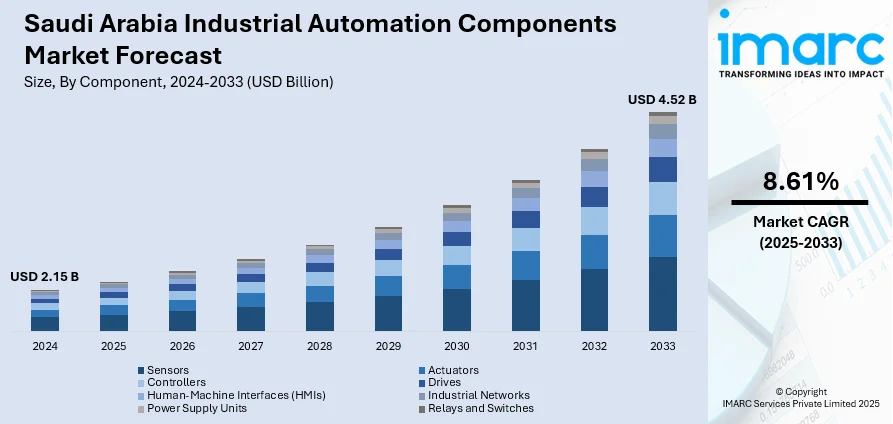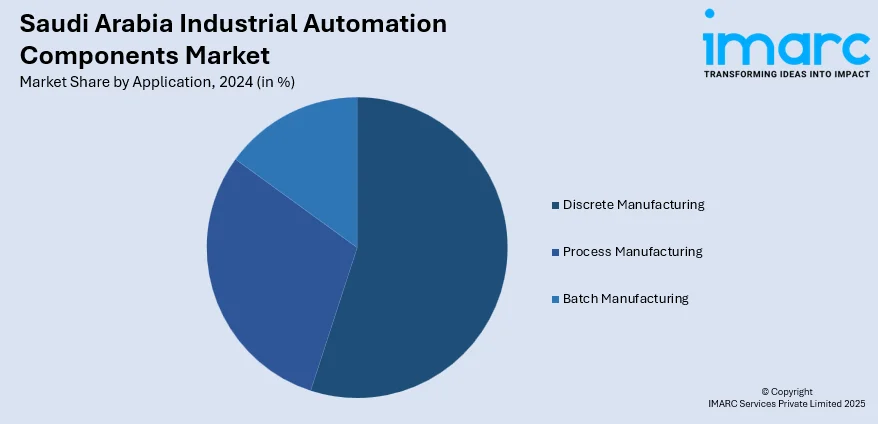
Saudi Arabia Industrial Automation Components Market Size, Share, Trends and Forecast by Component, Application, End Use Industry, and Region, 2025-2033
Saudi Arabia Industrial Automation Components Market
The Saudi Arabia industrial automation components market size reached USD 2.15 Billion in 2024. Looking forward, IMARC Group expects the market to reach USD 4.52 Billion by 2033, exhibiting a growth rate (CAGR) of 8.61% during 2025-2033. At present, with the transition of industries to digital and intelligent operations, smart factories need sophisticated automation technologies like sensors and actuators to facilitate effective and real-time process management. Besides this, increasing logistics activities are contributing to the expansion of the Saudi Arabia industrial automation components market share.
|
Report Attribute
|
Key Statistics
|
|---|---|
|
Base Year
|
2024
|
|
Forecast Years
|
2025-2033
|
|
Historical Years
|
2019-2024
|
| Market Size in 2024 | USD 2.15 Billion |
| Market Forecast in 2033 | USD 4.52 Billion |
| Market Growth Rate 2025-2033 | 8.61% |
Saudi Arabia Industrial Automation Components Market Trends:
Growing establishment of smart factories
The rising establishment of smart factories in Saudi Arabia is significantly driving the demand for industrial automation components. Smart factories need sophisticated automation technologies like sensors, programmable logic controllers (PLCs), actuators, and human-machine interfaces (HMIs) to enable effective and real-time process control as industries are transitioning to more digital and intelligent operations. These factories prioritize precision, energy efficiency, and high productivity, which are made feasible by the integration of automation technologies. The government's Vision 2030 initiative is promoting industrial modernization, leading to more investments in smart manufacturing technologies. Local industries, especially in oil and gas, petrochemicals, and food processing, are adopting automation to remain competitive and meet worldwide standards. Automation components help reduce human error, improve safety, and regulate resource use. With smart factories, operations are becoming more streamlined, flexible, and scalable, catalyzing the demand for connected and adaptive automation solutions. The need for predictive maintenance and data-based decision-making is also supporting the growth of automation technologies. Furthermore, the rising use of the Internet of Things (IoT) in industrial environments is boosting connectivity between machines, enabling remote monitoring and smart analytics. As per industry reports, the Saudi Arabia IoT market is expected to show strong growth during 2024-2029 with a CAGR of 17.5%.

To get more information of this market, Request Sample
Increasing logistics activities
Rising logistics activities are impelling the Saudi Arabia industrial automation components market growth. As the country is expanding its logistics infrastructure to become an international trade hub, there is an increasing need for faster, safer, and more efficient movement of goods. Automation components like sensors, conveyors, robotic arms, and control systems are used in warehouses, distribution centers, and ports to manage inventory, streamline operations, and reduce manual labor. These technologies help improve speed and accuracy in sorting, packing, and shipping processes. Government initiatives are further supporting the development of logistics zones and transport networks, driving the demand for automation. Companies are investing in modern facilities that rely heavily on automated systems to minimize operational costs and increase output. Automation also enables better tracking and data collection, leading to smarter logistics decisions. The expansion of retail and e-commerce adds pressure for quicker deliveries, encouraging automation in supply chain operations. As per industry reports, the KSA retail sector experienced growth with SAR 37.4 Billion in sales for Q3 2024. As logistics activities continue to rise, the demand for reliable and advanced automation components is becoming essential for meeting industry expectations and maintaining competitiveness.
Saudi Arabia Industrial Automation Components Market Segmentation:
IMARC Group provides an analysis of the key trends in each segment of the market, along with forecasts at the country and regional levels for 2025-2033. Our report has categorized the market based on component, application, and end use industry.
Component Insights:
- Sensors
- Actuators
- Controllers
- PLC
- DCS
- Drives
- Servo Drives
- VFDs
- Human-Machine Interfaces (HMIs)
- Industrial Networks
- Power Supply Units
- Relays and Switches
The report has provided a detailed breakup and analysis of the market based on the component. This includes sensors, actuators, controllers (PLC and DCS), drives (servo drives and VFDs), human-machine interfaces (HMIs), industrial networks, power supply units, and relays and switches.
Application Insights:

- Discrete Manufacturing
- Process Manufacturing
- Batch Manufacturing
A detailed breakup and analysis of the market based on the application have also been provided in the report. This includes discrete manufacturing, process manufacturing, and batch manufacturing.
End Use Industry Insights:
- Automotive
- Food and Beverage
- Pharmaceuticals
- Oil and Gas
- Chemicals
- Electronics and Semiconductors
- Metals and Mining
- Water and Wastewater
- Others
The report has provided a detailed breakup and analysis of the market based on the end use industry. This includes automotive, food and beverage, pharmaceuticals, oil and gas, chemicals, electronics and semiconductors, metals and mining, water and wastewater, and others.
Regional Insights:
- Northern and Central Region
- Western Region
- Eastern Region
- Southern Region
The report has also provided a comprehensive analysis of all the major regional markets, which include Northern and Central Region, Western Region, Eastern Region, and Southern Region.
Competitive Landscape:
The market research report has also provided a comprehensive analysis of the competitive landscape. Competitive analysis such as market structure, key player positioning, top winning strategies, competitive dashboard, and company evaluation quadrant has been covered in the report. Also, detailed profiles of all major companies have been provided.
Saudi Arabia Industrial Automation Components Market News:
- In December 2024, Saudi Energy Minister Prince Abdulaziz bin Salman visited various factories focused on manufacturing components for the energy industry in Riyadh Industrial City. The ministers and several senior officials were updated on the advancements in the production of energy devices and electrical panels for connectivity, regulation, automation, and distribution, along with plants for smart ring interconnection units for power plants. The tour was part of the continuous initiatives to improve localization in the energy industry, targeting a localization rate of 75% for sector components by 2030.
Saudi Arabia Industrial Automation Components Market Report Coverage:
| Report Features | Details |
|---|---|
| Base Year of the Analysis | 2024 |
| Historical Period | 2019-2024 |
| Forecast Period | 2025-2033 |
| Units | Billion USD |
| Scope of the Report |
Exploration of Historical Trends and Market Outlook, Industry Catalysts and Challenges, Segment-Wise Historical and Future Market Assessment:
|
| Components Covered |
|
| Applications Covered | Discrete Manufacturing, Process Manufacturing, Batch Manufacturing |
| End Use Industries Covered | Automotive, Food and Beverage, Pharmaceuticals, Oil and Gas, Chemicals, Electronics and Semiconductors, Metals and Mining, Water and Wastewater, Others |
| Regions Covered | Northern and Central Region, Western Region, Eastern Region, Southern Region |
| Customization Scope | 10% Free Customization |
| Post-Sale Analyst Support | 10-12 Weeks |
| Delivery Format | PDF and Excel through Email (We can also provide the editable version of the report in PPT/Word format on special request) |
Key Questions Answered in This Report:
- How has the Saudi Arabia industrial automation components market performed so far and how will it perform in the coming years?
- What is the breakup of the Saudi Arabia industrial automation components market on the basis of component?
- What is the breakup of the Saudi Arabia industrial automation components market on the basis of application?
- What is the breakup of the Saudi Arabia industrial automation components market on the basis of end use industry?
- What is the breakup of the Saudi Arabia industrial automation components market on the basis of region?
- What are the various stages in the value chain of the Saudi Arabia industrial automation components market?
- What are the key driving factors and challenges in the Saudi Arabia industrial automation components market?
- What is the structure of the Saudi Arabia industrial automation components market and who are the key players?
- What is the degree of competition in the Saudi Arabia industrial automation components market?
Key Benefits for Stakeholders:
- IMARC’s industry report offers a comprehensive quantitative analysis of various market segments, historical and current market trends, market forecasts, and dynamics of the Saudi Arabia industrial automation components market from 2019-2033.
- The research report provides the latest information on the market drivers, challenges, and opportunities in the Saudi Arabia industrial automation components market.
- Porter's five forces analysis assist stakeholders in assessing the impact of new entrants, competitive rivalry, supplier power, buyer power, and the threat of substitution. It helps stakeholders to analyze the level of competition within the Saudi Arabia industrial automation components industry and its attractiveness.
- Competitive landscape allows stakeholders to understand their competitive environment and provides an insight into the current positions of key players in the market.
Need more help?
- Speak to our experienced analysts for insights on the current market scenarios.
- Include additional segments and countries to customize the report as per your requirement.
- Gain an unparalleled competitive advantage in your domain by understanding how to utilize the report and positively impacting your operations and revenue.
- For further assistance, please connect with our analysts.
 Request Customization
Request Customization
 Speak to an Analyst
Speak to an Analyst
 Request Brochure
Request Brochure
 Inquire Before Buying
Inquire Before Buying




.webp)




.webp)












